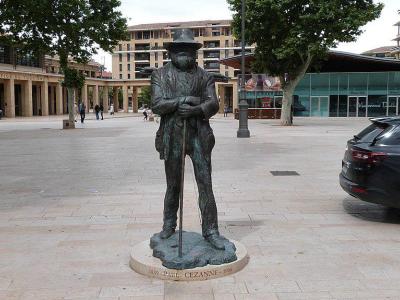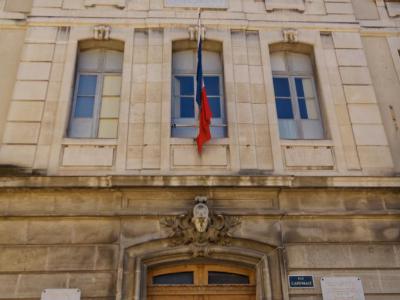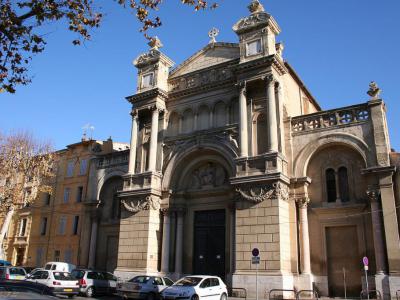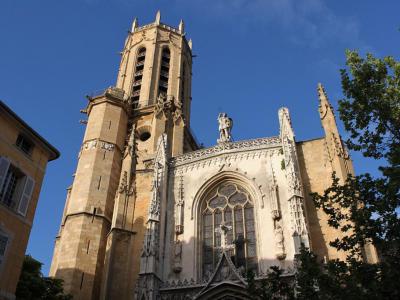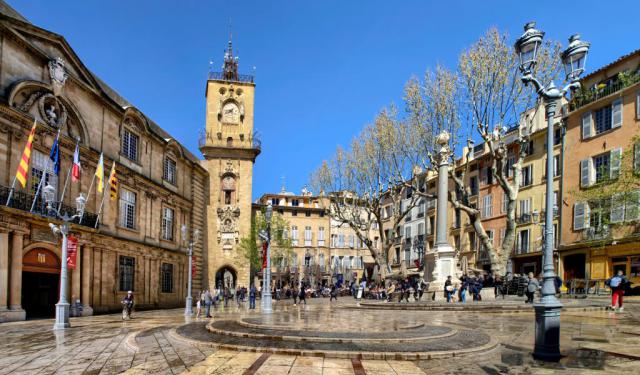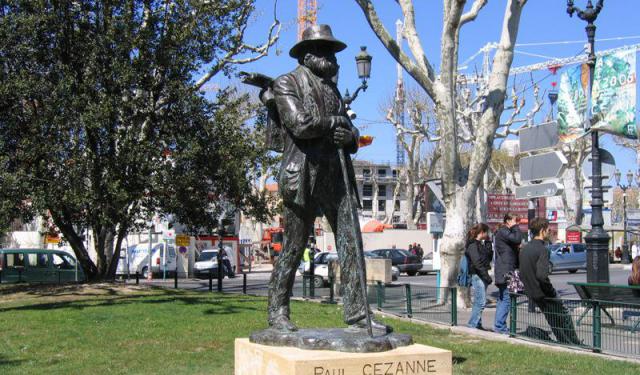
In the Footsteps of Paul Cézanne (Self Guided), Aix-en-Provence
Paul Cezanne created a scandal. While staying at the home of Doctor Paul Gachet in Auvers-sur-Oise, he painted an homage to Edouard Manet's work, Olympia, based on Titian's Venus of Urbino. Titian painted a goddess. Manet painted a prostitute. In his "New Olympia," Cezanne painted himself in the painting.
The nude New Olympia, seemingly a muse, reclines on her couch. Cezanne, his back turned, comes to worship. The painter's career was not going well. His father insisted Paul join the banking business. Paul tried, but he was ever loyal to his muse.
Paul Cezanne was born in Aix-en-Provence in 1839 in the house at 28 rue de l'Opera. Around the town are brass plaques marking the artist's trail through life. His studio in later life is at 9 Avenue Paul Cezanne. It's about a mile from La Rotonde, the center of town.
He was baptized at the Church of the Madeleine. At the age of ten, he entered St Joseph School in Aix. Among his classmates was sculptor Phillippe Solari. In 1852 Cezanne entered College Bourbon (now College Mignet) in Aix. His closest friends were Emile Zola (who later became a well-known novelist) and Baptistin Baille (who later became a professor of optics and acoustics). They were known as "The Three Insparables."
Paul studied drawing at the Municipal School of Drawing in Aix and The Aix School of Design in the Granet Museum. His banker father acquired the new family house, Jan de Bouffan, in 1859. The property was a favorite work locale for Paul for many years.
Off and on, Cezanne studied and worked in Paris. He was twice turned down at the Ecole des Beaux-Arts (School of Fine Arts). At the Academie Suisse he met painter Camille Pissarro and Achille Emperaire, also from Aix. Paul returned home to Aix, but in 1862 he was back in Paris. Friends and associates there included: Monet, Renoir, Courbet, and Delacroix.
Cezanne's places to visit in Aix include his second boyhood home on rue Matheron; Church of the Madeleine; College Mignet; Granet Museum; homestead Jan de Bouffan; Aix Hotel-de-Ville; and Cezanne's last home in Aix at 23 rue Boulegon. Cezanne died in 1906. He is buried at St Pierre Cemetery in Aix.
The nude New Olympia, seemingly a muse, reclines on her couch. Cezanne, his back turned, comes to worship. The painter's career was not going well. His father insisted Paul join the banking business. Paul tried, but he was ever loyal to his muse.
Paul Cezanne was born in Aix-en-Provence in 1839 in the house at 28 rue de l'Opera. Around the town are brass plaques marking the artist's trail through life. His studio in later life is at 9 Avenue Paul Cezanne. It's about a mile from La Rotonde, the center of town.
He was baptized at the Church of the Madeleine. At the age of ten, he entered St Joseph School in Aix. Among his classmates was sculptor Phillippe Solari. In 1852 Cezanne entered College Bourbon (now College Mignet) in Aix. His closest friends were Emile Zola (who later became a well-known novelist) and Baptistin Baille (who later became a professor of optics and acoustics). They were known as "The Three Insparables."
Paul studied drawing at the Municipal School of Drawing in Aix and The Aix School of Design in the Granet Museum. His banker father acquired the new family house, Jan de Bouffan, in 1859. The property was a favorite work locale for Paul for many years.
Off and on, Cezanne studied and worked in Paris. He was twice turned down at the Ecole des Beaux-Arts (School of Fine Arts). At the Academie Suisse he met painter Camille Pissarro and Achille Emperaire, also from Aix. Paul returned home to Aix, but in 1862 he was back in Paris. Friends and associates there included: Monet, Renoir, Courbet, and Delacroix.
Cezanne's places to visit in Aix include his second boyhood home on rue Matheron; Church of the Madeleine; College Mignet; Granet Museum; homestead Jan de Bouffan; Aix Hotel-de-Ville; and Cezanne's last home in Aix at 23 rue Boulegon. Cezanne died in 1906. He is buried at St Pierre Cemetery in Aix.
How it works: Download the app "GPSmyCity: Walks in 1K+ Cities" from Apple App Store or Google Play Store to your mobile phone or tablet. The app turns your mobile device into a personal tour guide and its built-in GPS navigation functions guide you from one tour stop to next. The app works offline, so no data plan is needed when traveling abroad.
In the Footsteps of Paul Cézanne Map
Guide Name: In the Footsteps of Paul Cézanne
Guide Location: France » Aix-en-Provence (See other walking tours in Aix-en-Provence)
Guide Type: Self-guided Walking Tour (Sightseeing)
# of Attractions: 8
Tour Duration: 2 Hour(s)
Travel Distance: 3.0 Km or 1.9 Miles
Author: nataly
Sight(s) Featured in This Guide:
Guide Location: France » Aix-en-Provence (See other walking tours in Aix-en-Provence)
Guide Type: Self-guided Walking Tour (Sightseeing)
# of Attractions: 8
Tour Duration: 2 Hour(s)
Travel Distance: 3.0 Km or 1.9 Miles
Author: nataly
Sight(s) Featured in This Guide:
- Statue de Paul Cezanne (Statue of Paul Cezanne)
- Collège Mignet (Mignet College)
- Musee Granet (Granet Museum)
- Maison Natale de Cezanne (Cezanne's Birth House)
- Eglise de la Madeleine (Church of the Madeleine)
- Hôtel de Ville d'Aix-en-Provence (Town Hall)
- Cathedrale Saint-Sauveur d'Aix-en-Provence (Aix Cathedral)
- Atelier de Cezanne (Cezanne's Studio)
1) Statue de Paul Cezanne (Statue of Paul Cezanne)
The Statue de Paul Cezanne (Statue of Paul Cezanne) faces the Rotunda of Aix. He is dressed in a jacket and work clothes. A full-brimmed hat shades his bearded face. His art gear and perhaps his lunch is carried in his backpack. He rests his hands on his walking stick. He peers speculatively from under his hat brim.
Made of bronze, over six feet high, he stands on a stone plinth bearing his name. Dutch-born sculptor Gabriel Sterk, a great fan of Paul Cezanne, created the work. It was presented to the city in 2006 to mark the 100th anniversary of Cezanne's death.
Cezanne was born in Aix on the 19th of January, 1839. He became a member of the impressionist art movement. He was also considered to be the precursor of post-impressionism and cubism. He continued French classicism as much as radical innovation through his use of geometry in his portraits and nature studies, especially those around Aix-en-Provence.
Cezanne is most noted for his series of canvases having as a motif the mountain Sainte-Victoire outside Aix. To this day, he is celebrated as the Father of Modern Art.
Made of bronze, over six feet high, he stands on a stone plinth bearing his name. Dutch-born sculptor Gabriel Sterk, a great fan of Paul Cezanne, created the work. It was presented to the city in 2006 to mark the 100th anniversary of Cezanne's death.
Cezanne was born in Aix on the 19th of January, 1839. He became a member of the impressionist art movement. He was also considered to be the precursor of post-impressionism and cubism. He continued French classicism as much as radical innovation through his use of geometry in his portraits and nature studies, especially those around Aix-en-Provence.
Cezanne is most noted for his series of canvases having as a motif the mountain Sainte-Victoire outside Aix. To this day, he is celebrated as the Father of Modern Art.
2) Collège Mignet (Mignet College)
Mignet College is named after Francois-Auguste Mignet, a 19th-century historian and journalist. The educational establishment is located on Cardinal Street in the Mazarin district of Aix. It was authorized as a royal college in 1603 by King Henri IV. The college was under the authority of the Jesuits (a Roman Catholic order of priests and brothers ) until 1773 and then managed by the Doctrinaire Fathers, expelled in 1790.
During the Napoleonic era, the college reopened. With the momentary Restoration of the Monarchy, it was "College Bourbon." It is housed in the former convents of the Benedictines and the Ursulines. The city bought the college in 1878 and changed it to a High School under the name Zola High School (Lycée Zola). It became Mignet College in 1976.
The facade of the building on Cardinale Street came about from joining the Ursuline and Benedictine buildings. The complex has been partially registered and classified as a historical monument since 1913. The classified portions are the former entrance of the convent of the Benedictines (now the southeast facade) and the grand staircase of Honor.
Famous former students are Jean-Baptiste Baille, scientist; Paul Cezanne, painter; Darius Milhaud, composer; and Emile Zola, writer. Marcel Pagnol, a writer and faculty member, was an English tutor. Cezanne and Zola were inseparable friends at school. Cezanne received his baccalaureate in 1858 with the notation, "quite well."
During the Napoleonic era, the college reopened. With the momentary Restoration of the Monarchy, it was "College Bourbon." It is housed in the former convents of the Benedictines and the Ursulines. The city bought the college in 1878 and changed it to a High School under the name Zola High School (Lycée Zola). It became Mignet College in 1976.
The facade of the building on Cardinale Street came about from joining the Ursuline and Benedictine buildings. The complex has been partially registered and classified as a historical monument since 1913. The classified portions are the former entrance of the convent of the Benedictines (now the southeast facade) and the grand staircase of Honor.
Famous former students are Jean-Baptiste Baille, scientist; Paul Cezanne, painter; Darius Milhaud, composer; and Emile Zola, writer. Marcel Pagnol, a writer and faculty member, was an English tutor. Cezanne and Zola were inseparable friends at school. Cezanne received his baccalaureate in 1858 with the notation, "quite well."
3) Musee Granet (Granet Museum) (must see)
Henri Pointier, the curator of the Museum of Aix from 1892 to 1925, despised Cezanne. He is said to have declared Cézanne would only be shown there "Over my dead body." Mr. Pointier proved to be prophetic. He died in 1949, and the hunt was on for works by Cezanne. In the same year, the Aix museum took the name of one of its most generous benefactors, the local painter François-Marius Granet.
The Musee Granet (Granet Museum) first opened in a building once the property of the priory of Saint Jean-de-Malte. Today it still shares a garden with the church. In 2009 it mounted an exhibition marking the 100th anniversary of Cezanne's death, absolutely a painter's revenge.
The museum contains paintings by Jean-Dominique Ingres, including the massive masterpiece "Jupiter and Thetis." There is a self-portrait by Rembrandt and other works by Van Dyck, Cezanne, Giacometti, and de Stael.
In June 2011, the Foundation Jean et Suzanne Planque opened a show at the Granet Museum. It contained over 180 works, all the legacy of the great Swiss collector Jean Planque. The collection has a run of 15 years at the museum.
The complete collection will number more than 300 works of art. Degas, Renoir, Monet, Cezanne, Van Gogh, Picasso, Bonnard, Klee, Giacometti, and Dubuffet will be there. The show is housed in a special annex in the Chapel of the White Penitents.
The Musee Granet (Granet Museum) first opened in a building once the property of the priory of Saint Jean-de-Malte. Today it still shares a garden with the church. In 2009 it mounted an exhibition marking the 100th anniversary of Cezanne's death, absolutely a painter's revenge.
The museum contains paintings by Jean-Dominique Ingres, including the massive masterpiece "Jupiter and Thetis." There is a self-portrait by Rembrandt and other works by Van Dyck, Cezanne, Giacometti, and de Stael.
In June 2011, the Foundation Jean et Suzanne Planque opened a show at the Granet Museum. It contained over 180 works, all the legacy of the great Swiss collector Jean Planque. The collection has a run of 15 years at the museum.
The complete collection will number more than 300 works of art. Degas, Renoir, Monet, Cezanne, Van Gogh, Picasso, Bonnard, Klee, Giacometti, and Dubuffet will be there. The show is housed in a special annex in the Chapel of the White Penitents.
4) Maison Natale de Cezanne (Cezanne's Birth House)
Paul Cezanne was born on January 19th, 1839. His father, Louis-Auguste Cezanne, was a milliner who would later be a successful banker. His mother was Elisabeth-Honorine Aubert. They lived in a house at 28 Opera Street (Rue de l'Opera) in Aix. For the first ten years of Paul's life, the family resided at number 28.
In 1844 the family lived at 14 Glacier Street (rue de la Glaciere). Louis-Auguste is mentioned as a former hatter and house owner in the marriage contract, drawn up at this address on January 10th.
Church of the Madeleine on Preachers Square was the site of his parent's marriage. It was also the site of his sister Marie's baptism in 1841 and the marriage ceremony of Paul's second sister, Rose, in 1881. From 1850 to 1870, the Cezannes lived at 14 Matheron Street, a brief walk from Opera Street.
Paul Cezanne would leave Aix-en-Provence on occasion, but he would always return. There are trails of places where he lived and worked in his beloved city. He attended the Municipal School on Epinaux Street, the Mignet High School at Cardinal Street, and the Art School of the Granet Museum on Saint John of Malta Square.
He married Hortense Fiquet at the Church of St Jean-Baptiste du Faubourg. He liked to share drinks with friends at the city's legendary brasserie "The Two Boys" (Les Deux Garcons) on the Mirabeau Square. There are brass markers on buildings, squares, and monuments throughout the Old City, marking his trail through life and career.
In 1844 the family lived at 14 Glacier Street (rue de la Glaciere). Louis-Auguste is mentioned as a former hatter and house owner in the marriage contract, drawn up at this address on January 10th.
Church of the Madeleine on Preachers Square was the site of his parent's marriage. It was also the site of his sister Marie's baptism in 1841 and the marriage ceremony of Paul's second sister, Rose, in 1881. From 1850 to 1870, the Cezannes lived at 14 Matheron Street, a brief walk from Opera Street.
Paul Cezanne would leave Aix-en-Provence on occasion, but he would always return. There are trails of places where he lived and worked in his beloved city. He attended the Municipal School on Epinaux Street, the Mignet High School at Cardinal Street, and the Art School of the Granet Museum on Saint John of Malta Square.
He married Hortense Fiquet at the Church of St Jean-Baptiste du Faubourg. He liked to share drinks with friends at the city's legendary brasserie "The Two Boys" (Les Deux Garcons) on the Mirabeau Square. There are brass markers on buildings, squares, and monuments throughout the Old City, marking his trail through life and career.
5) Eglise de la Madeleine (Church of the Madeleine)
The Eglise de la Madeleine (Church of the Madeleine) can be found in Preachers Square in Aix, next to the former Preachers Convent, now a public school. The Dominican church and convent were built in the 13th century. The church, originally a Gothic-style building, burned in 1383. Rebuilt, it came down again in 1465.
The present church dates from 1703. The religious edifice was designed by the local architect Laurent Vallon. The facade of the building, a sample of the Second Empire style, was created by architect Henri Revoil. The exterior has an awesome retable showing the Annunciation. The interior of the church is enormous but in the plain Dominican spirit.
The church houses an exceptional collection of sacred art, including the altar statue of Our Lady of the Graces, given by Saint Bonaventura. Paintings inside include The Death of Saint Joseph by Jean-Baptiste van Loo; Magdelene at the home of Simon by Michel Serre; the Annunciations Tryptych by Barthelemy d'Eyck; and works by Jean Daret.
Paul Cezanne was baptized in the church, as was his elder sister Marie. His parents were married here. His younger sister Rose was also married in the church to attorney Maxime Conil in 1881.
The present church dates from 1703. The religious edifice was designed by the local architect Laurent Vallon. The facade of the building, a sample of the Second Empire style, was created by architect Henri Revoil. The exterior has an awesome retable showing the Annunciation. The interior of the church is enormous but in the plain Dominican spirit.
The church houses an exceptional collection of sacred art, including the altar statue of Our Lady of the Graces, given by Saint Bonaventura. Paintings inside include The Death of Saint Joseph by Jean-Baptiste van Loo; Magdelene at the home of Simon by Michel Serre; the Annunciations Tryptych by Barthelemy d'Eyck; and works by Jean Daret.
Paul Cezanne was baptized in the church, as was his elder sister Marie. His parents were married here. His younger sister Rose was also married in the church to attorney Maxime Conil in 1881.
6) Hôtel de Ville d'Aix-en-Provence (Town Hall)
The Hotel de Ville, or Town Hall, is one of the most interesting historic locations in Aix-en-Provence, situated on the eponymous Town Hall Square (Place de l'Hotel-de-Ville). Renowned for its Italianate façade, carved wood front door, and inner courtyard, the current Town Hall is a rebuild of the original structure that once stood on the site until the middle of the 14th century.
The new Town Hall, comprising two levels and a ground floor, was built between 1655 and 1678 by the architect Pierre Pavillon assisted by the sculptors Jean-Claude Rambot and Jacques Fosse.
The Baroque-style façade, once richly decorated, was largely stripped of its ornamentation during the French Revolution of 1789. The resulting decorum features a handful of elements. Each floor, consisting of five windows, is separated by a frieze and is delimited by an entablature decorated with fruit garlands. The whole structure is flanked by two large buttresses that give it a rather monumental look. The ground floor frieze is decorated with triglyphs and rosettes, while that on the second floor is decorated with foliage snaking in opposite directions.
Inside the Salle des Etats de Provence, on the first floor, are the two series of paintings, including portraits of the counts of Provence and the kings of France on the one hand, and on the other, those illustrating the history of Aix and Provence.
The Town Hall building is also notable for the adjoining Clock Tower, built in 1510, which holds an astronomical clock dating from 1661. The base of the tower reveals ancient blocks of white limestone that probably originated from the former Roman gate of the city. Crowning the structure is a 16th-century wrought-iron cage with a bell. During medieval times, this bell was used to announce an exercise of Seigneurial rights, which obliged peasants to provide the landowner with seigneurial dues, paid either in cash, produce, or labor.
It is in this building the famous French painter, Paul Cézanne, married the love of his life, Marie-Hortense Fiquet, in 1886. Fiquet appeared in 27 of Paul Cézanne paintings.
The Town Hall of Aix-en-Provence was classified as a historical monument in 1995.
The new Town Hall, comprising two levels and a ground floor, was built between 1655 and 1678 by the architect Pierre Pavillon assisted by the sculptors Jean-Claude Rambot and Jacques Fosse.
The Baroque-style façade, once richly decorated, was largely stripped of its ornamentation during the French Revolution of 1789. The resulting decorum features a handful of elements. Each floor, consisting of five windows, is separated by a frieze and is delimited by an entablature decorated with fruit garlands. The whole structure is flanked by two large buttresses that give it a rather monumental look. The ground floor frieze is decorated with triglyphs and rosettes, while that on the second floor is decorated with foliage snaking in opposite directions.
Inside the Salle des Etats de Provence, on the first floor, are the two series of paintings, including portraits of the counts of Provence and the kings of France on the one hand, and on the other, those illustrating the history of Aix and Provence.
The Town Hall building is also notable for the adjoining Clock Tower, built in 1510, which holds an astronomical clock dating from 1661. The base of the tower reveals ancient blocks of white limestone that probably originated from the former Roman gate of the city. Crowning the structure is a 16th-century wrought-iron cage with a bell. During medieval times, this bell was used to announce an exercise of Seigneurial rights, which obliged peasants to provide the landowner with seigneurial dues, paid either in cash, produce, or labor.
It is in this building the famous French painter, Paul Cézanne, married the love of his life, Marie-Hortense Fiquet, in 1886. Fiquet appeared in 27 of Paul Cézanne paintings.
The Town Hall of Aix-en-Provence was classified as a historical monument in 1995.
7) Cathedrale Saint-Sauveur d'Aix-en-Provence (Aix Cathedral) (must see)
The 17th-century French writer and historian Jean Scholastique Pitton claimed the Aix Cathedral (Cathedrale Saint-Sauveur d'Aix-en-Provence) was built on the top of a Roman temple dedicated to Apollo, one of the Olympian deities in classical Greek and Roman religion and mythology. Tradition holds that the first church on the site was founded by Saint Maximinus in 500 AD. It is said that Maximinus arrived in Aix from Jerusalem with Mary Magdalene in a boat on loan from Saint Lazarus.
The current Cathedral of Aix was built in the 12th century. It had Romanesque walls and one wide nave. A second nave, dedicated to Saint Maximinus, was established between the first nave and the baptistry in 1171. Two new wings of the transept, built in the Gothic style, were added in 1318.
The main portal doors, made of carved red walnut, were installed in 1505. The western facade has extravagant Gothic portals. The yellowish buttresses have lengthy, narrow niches with pinnacles. Three statues of the Apostles stand on either side of the doorway. The remaining six Apostles hide in the side buttresses on each side.
Above the portal and gable, a statue of the archangel Michael, sculpted by Jean Paumier in 1507, skewers a supine dragon on the Gothic balustrade of the facade. The single 16th-century bell tower is 210 feet high.
The Aix Cathedral has a triple nave: a Romanesque side aisle, a Gothic central nave, and a Baroque 17th-century north aisle. The bishop's throne is in the Choir Gallery. The altar is supported by three bronze statues representing the Holy Trinity. The Baptistry Rotunda and its Roman columns date from the 5th century.
Artworks in the Cathedral include the Burning Bush Triptych (1475-1476) by French painter Nicolas Froment; Christ on the Cross (1640) and The Last Supper (1688) by Flemish artist Jean Daret; The Incredulity of Saint Thomas (1613) by Louis Finson, the follower of the famous Italian painter Caravaggio; the Altar of the Aygosi Family placed in the cathedral in 1823; and a set of 17 tapestries of the Life of Christ bought in 1656. The tapestries were woven in 1511 for Canterbury Cathedral in England and decorated the choir until 1642.
Paul Cezanne, the father of the cubist movement in France, was a native of Aix. He claimed it was the best place to live. He painted several canvases of the Aix Cathedral, a short walk from his studio. His funeral was held there in October 1906.
The current Cathedral of Aix was built in the 12th century. It had Romanesque walls and one wide nave. A second nave, dedicated to Saint Maximinus, was established between the first nave and the baptistry in 1171. Two new wings of the transept, built in the Gothic style, were added in 1318.
The main portal doors, made of carved red walnut, were installed in 1505. The western facade has extravagant Gothic portals. The yellowish buttresses have lengthy, narrow niches with pinnacles. Three statues of the Apostles stand on either side of the doorway. The remaining six Apostles hide in the side buttresses on each side.
Above the portal and gable, a statue of the archangel Michael, sculpted by Jean Paumier in 1507, skewers a supine dragon on the Gothic balustrade of the facade. The single 16th-century bell tower is 210 feet high.
The Aix Cathedral has a triple nave: a Romanesque side aisle, a Gothic central nave, and a Baroque 17th-century north aisle. The bishop's throne is in the Choir Gallery. The altar is supported by three bronze statues representing the Holy Trinity. The Baptistry Rotunda and its Roman columns date from the 5th century.
Artworks in the Cathedral include the Burning Bush Triptych (1475-1476) by French painter Nicolas Froment; Christ on the Cross (1640) and The Last Supper (1688) by Flemish artist Jean Daret; The Incredulity of Saint Thomas (1613) by Louis Finson, the follower of the famous Italian painter Caravaggio; the Altar of the Aygosi Family placed in the cathedral in 1823; and a set of 17 tapestries of the Life of Christ bought in 1656. The tapestries were woven in 1511 for Canterbury Cathedral in England and decorated the choir until 1642.
Paul Cezanne, the father of the cubist movement in France, was a native of Aix. He claimed it was the best place to live. He painted several canvases of the Aix Cathedral, a short walk from his studio. His funeral was held there in October 1906.
8) Atelier de Cezanne (Cezanne's Studio) (must see)
Atelier de Cezanne (Cezanne's Studio) is a museum about the painter Paul Cézanne. It was his studio from 1902 until his death in 1906.
In November 1901, after the death of his mother and the sale of family property in Aix-en-Provence, Cézanne bought an old farmhouse and 7000 square metres of land on the Lauves hill near the city. It has a view of Montagne Sainte-Victoire, the subject of many oil paintings and watercolours by the artist.
He constructed a studio on the upper floor, lit by large windows on the south side and a glass roof to the north; it was completed in September 1902. The ground floor was used for daily life, and he worked in the studio, creating paintings including The Bathers.
After his death, it passed to his son Paul; it was bought in 1921 by Marcel Joannon (known as Marcel Provence), an admirer of Cézanne. He occupied only the ground floor, leaving the studio upstairs as Cézanne had left it. Artists and art historians, including John Rewald, came to visit. After Joannon's death, John Rewald and the writer James Lord established the Cézanne Memorial Committee; in 1952 the committee had enough funds to purchase the property, which was converted into a museum.
The building is now owned by the Tourist Office of Aix-en-Provence. In Cézanne's former studio there is his work equipment, the models of his final still life paintings and his furniture; there are some watercolours and drawings by the artist. Temporary exhibitions are held, and cultural events take place.
The building was given in 2012 the designation Maison des Illustres.
In November 1901, after the death of his mother and the sale of family property in Aix-en-Provence, Cézanne bought an old farmhouse and 7000 square metres of land on the Lauves hill near the city. It has a view of Montagne Sainte-Victoire, the subject of many oil paintings and watercolours by the artist.
He constructed a studio on the upper floor, lit by large windows on the south side and a glass roof to the north; it was completed in September 1902. The ground floor was used for daily life, and he worked in the studio, creating paintings including The Bathers.
After his death, it passed to his son Paul; it was bought in 1921 by Marcel Joannon (known as Marcel Provence), an admirer of Cézanne. He occupied only the ground floor, leaving the studio upstairs as Cézanne had left it. Artists and art historians, including John Rewald, came to visit. After Joannon's death, John Rewald and the writer James Lord established the Cézanne Memorial Committee; in 1952 the committee had enough funds to purchase the property, which was converted into a museum.
The building is now owned by the Tourist Office of Aix-en-Provence. In Cézanne's former studio there is his work equipment, the models of his final still life paintings and his furniture; there are some watercolours and drawings by the artist. Temporary exhibitions are held, and cultural events take place.
The building was given in 2012 the designation Maison des Illustres.
Sight description based on Wikipedia.
Walking Tours in Aix-en-Provence, France
Create Your Own Walk in Aix-en-Provence
Creating your own self-guided walk in Aix-en-Provence is easy and fun. Choose the city attractions that you want to see and a walk route map will be created just for you. You can even set your hotel as the start point of the walk.
Aix-en-Provence Introduction Walking Tour
Aix-en-Provence is a city in southern France, about 30 km (or 20 mi) north of Marseille. Aix was founded by Roman Consul Sextius Calvinus in 123 BC. Calvinus called it Aquae Sextiae, which means "Waters of Sextius," after the warm springs in the area. During the Middle Ages, it was the capital of Provence.
Aix reached a high point after the 12th century as it began to emerge as a... view more
Tour Duration: 1 Hour(s)
Travel Distance: 1.7 Km or 1.1 Miles
Aix reached a high point after the 12th century as it began to emerge as a... view more
Tour Duration: 1 Hour(s)
Travel Distance: 1.7 Km or 1.1 Miles
Aix-en-Provence Fountains and Squares Tour
Aix-end-Provence is known for its fountains. With more than 1,000 fountains, a tourist could spend weeks walking around the city without glimpsing them all. The fountains began appearing under the Roman empire when the Romans discovered Aix's natural thermal water source. They referred to the area as Aquae Sextiae or the Waters of Sextius.
The fountains appear throughout the city and are... view more
Tour Duration: 1 Hour(s)
Travel Distance: 1.6 Km or 1 Miles
The fountains appear throughout the city and are... view more
Tour Duration: 1 Hour(s)
Travel Distance: 1.6 Km or 1 Miles
The Most Popular Cities
/ view all
